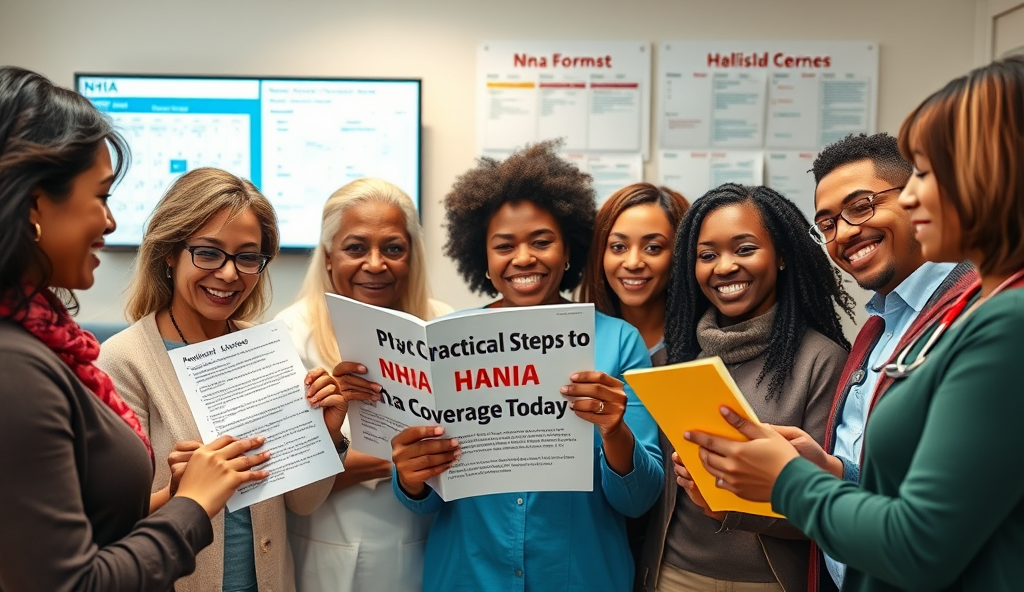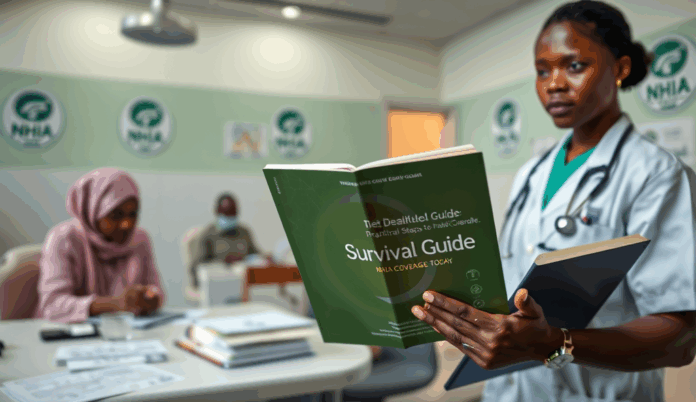Introduction to NHIA Coverage in Nigeria
The National Health Insurance Authority (NHIA) serves as Nigeria’s primary framework for expanding healthcare access through structured financing. With an estimated coverage rate of just 7% as of 2023, the NHIA faces significant challenges in reaching its goal of universal health coverage for Nigerian citizens.
Key initiatives like the Formal Sector Program and Vulnerable Group Fund aim to bridge gaps, yet disparities persist between urban and rural enrollment rates. For instance, Lagos State accounts for nearly 30% of total enrollments, while states like Zamfara lag below 2%.
Understanding these dynamics is crucial for policymakers to refine NHIA insurance plans and policies effectively. The next section will delve deeper into the definition and importance of NHIA coverage in Nigeria’s healthcare landscape.
Key Statistics

Definition and Importance of NHIA Coverage
The National Health Insurance Authority (NHIA) serves as Nigeria’s primary framework for expanding healthcare access through structured financing.
NHIA coverage refers to the structured health insurance benefits for Nigerian citizens under the National Health Insurance Authority, designed to reduce out-of-pocket healthcare expenses. With only 7% coverage as of 2023, expanding enrollment remains critical to achieving universal healthcare access, particularly for vulnerable groups and formal sector workers.
The importance of NHIA coverage lies in its potential to bridge Nigeria’s healthcare financing gap, ensuring essential services reach underserved populations. For instance, Lagos’s higher enrollment rates (30%) demonstrate how structured insurance can improve healthcare access compared to states like Zamfara (below 2%).
Understanding NHIA coverage’s scope helps policymakers refine eligibility criteria and financing options for broader inclusion. The next section will explore the historical evolution of NHIA, providing context for its current challenges and opportunities.
Historical Background of NHIA in Nigeria
NHIA coverage refers to the structured health insurance benefits for Nigerian citizens under the National Health Insurance Authority, designed to reduce out-of-pocket healthcare expenses.
The National Health Insurance Authority (NHIA) traces its origins to the 1960s when Nigeria first explored social health insurance models, culminating in the formal establishment of the National Health Insurance Scheme (NHIS) through Act 35 of 1999. This legislation aimed to address Nigeria’s healthcare financing challenges by mandating contributions from formal sector workers, though implementation remained slow until the 2005 operational launch.
By 2014, NHIS coverage reached just 3% of Nigerians, exposing systemic challenges like limited state participation and inadequate funding mechanisms. The scheme’s rebranding to NHIA in 2022 under Act 46 sought to strengthen enforcement powers and expand coverage through decentralized state health insurance schemes, building on lessons from pilot programs in Lagos and Delta states.
These historical developments explain today’s uneven NHIA coverage rates, setting the stage for analyzing current enrollment patterns. The next section will examine how these foundational challenges persist in Nigeria’s 7% national coverage rate as of 2023.
Current NHIA Coverage Rate in Nigeria
Despite structural reforms since 2022, NHIA coverage remains low at 7% nationally as of 2023, reflecting persistent gaps between policy intentions and implementation realities.
Despite structural reforms since 2022, NHIA coverage remains low at 7% nationally as of 2023, reflecting persistent gaps between policy intentions and implementation realities. This marginal improvement from the 3% recorded in 2014 underscores ongoing challenges in expanding NHIA health insurance benefits to Nigeria’s 220 million citizens, particularly in rural areas where enrollment rates lag behind urban centers.
State-level disparities persist, with Lagos achieving 12% coverage through its contributory scheme while northern states like Kano struggle below 4%, mirroring historical participation gaps. The NHIA healthcare services framework now includes vulnerable groups through programs like the Basic Health Care Provision Fund, yet only 15 million Nigerians currently access these benefits.
These coverage patterns set the stage for examining the socioeconomic and administrative factors influencing NHIA enrollment, which the next section will analyze in depth. The data reveals both progress and unmet potential in Nigeria’s quest for universal health coverage through the NHIA system.
Factors Influencing NHIA Coverage Rates
Operational inefficiencies exacerbate Nigeria's NHIA coverage gaps, with only 42% of healthcare facilities nationwide meeting NHIA accreditation standards.
The persistent 7% national NHIA coverage rate reflects complex socioeconomic barriers, including low awareness in rural communities where only 23% of residents understand NHIA health insurance benefits compared to 58% in urban centers. Income disparities further limit enrollment, as 40% of Nigerians live below the poverty line and prioritize immediate needs over insurance premiums.
Administrative hurdles like cumbersome NHIA enrollment processes and limited service centers in northern states contribute to regional gaps, explaining why Kano’s 4% coverage lags behind Lagos’ 12%. Cultural perceptions also play a role, with only 31% of informal sector workers trusting insurance schemes despite eligibility for NHIA healthcare services.
These systemic challenges create a compounding effect on coverage rates, setting the stage for examining operational obstacles in the next section. The interplay of economic, geographic, and institutional factors underscores why Nigeria’s universal health coverage targets remain unmet despite policy reforms.
Challenges Facing NHIA Coverage Expansion
Nigeria’s NHIA coverage rate of 7% lags behind Ghana’s 45% and Rwanda’s 90%, where mandatory enrollment and decentralized community-based schemes have proven effective.
Operational inefficiencies exacerbate Nigeria’s NHIA coverage gaps, with only 42% of healthcare facilities nationwide meeting NHIA accreditation standards, disproportionately affecting rural areas where 68% of providers lack capacity to process claims. Delayed reimbursement cycles averaging 90 days discourage provider participation, particularly in states like Sokoto where just 12% of hospitals accept NHIA insurance despite high disease burdens.
The fragmented state health insurance schemes create parallel systems that confuse beneficiaries, evidenced by Cross River State’s overlapping enrollment databases causing 15% duplicate registrations. This structural complexity undermines NHIA healthcare services integration, particularly for interstate migrants who constitute 32% of Nigeria’s workforce but face coverage discontinuities.
Technological limitations further hinder progress, as manual verification processes account for 40% of NHIA enrollment delays according to 2023 NHIS operational reports. These systemic bottlenecks compound the socioeconomic barriers discussed earlier, necessitating urgent government and stakeholder interventions to streamline processes, which the next section will explore.
Government and Stakeholder Efforts to Improve Coverage
To address NHIA coverage gaps, the federal government launched the Expanded Tertiary Institutions Social Health Insurance Program (ETISHIP) in 2023, targeting 12 million students and staff across 52 universities, though implementation delays persist in 30% of beneficiary institutions. Private sector partnerships like MTN’s mobile enrollment platform have reduced manual verification bottlenecks by 25% in pilot states, demonstrating scalable solutions for Nigeria’s interstate migrant workforce.
State governments are harmonizing fragmented schemes, with Lagos eliminating duplicate registrations through biometric integration, while Kebbi’s NHIA fast-track accreditation increased participating rural clinics from 18% to 41% within 18 months. These localized interventions complement the NHIA’s nationwide provider network expansion, which added 620 facilities in 2023 but still falls short of universal coverage targets.
The Central Bank’s Healthcare Sector Intervention Fund now offers low-interest loans to hospitals for NHIA compliance upgrades, addressing the 68% rural provider capacity deficit highlighted earlier. As these multi-stakeholder efforts gain traction, benchmarking against regional peers—examined next—could reveal additional strategies for accelerating Nigeria’s health insurance penetration.
Comparative Analysis with Other African Countries
Nigeria’s NHIA coverage rate of 7% lags behind Ghana’s 45% and Rwanda’s 90%, where mandatory enrollment and decentralized community-based schemes have proven effective. Unlike Nigeria’s fragmented state-level initiatives, Ghana’s National Health Insurance Scheme (NHIS) leverages a centralized digital platform, reducing duplicate registrations by 60%—a lesson for Lagos’ ongoing biometric integration efforts.
South Africa’s NHI pilot projects demonstrate how private-sector collaboration, similar to Nigeria’s MTN partnership, can bridge urban-rural divides, with telemedicine reducing provider gaps by 30% in remote areas. Kenya’s Linda Mama program, targeting vulnerable groups, mirrors Nigeria’s ETISHIP but achieves 80% maternal coverage through mobile payment integrations—a model for scaling NHIA benefits for enrollees in Nigeria’s informal sector.
While Nigeria’s 620 new NHIA facilities in 2023 show progress, Morocco’s RAMED scheme highlights the impact of subsidized premiums, covering 60% of low-income populations within five years. These benchmarks underscore the urgency of Nigeria’s Healthcare Sector Intervention Fund to replicate regional successes in accelerating universal health insurance penetration, a foundation for future projections.
Future Projections for NHIA Coverage in Nigeria
Building on regional successes like Ghana’s digital integration and Kenya’s mobile payment systems, Nigeria’s NHIA could achieve 30% coverage by 2030 if current expansion trends continue, provided annual enrollment grows at 15%—a target requiring sustained investment in biometric verification and informal sector engagement. The Healthcare Sector Intervention Fund’s planned ₦50 billion allocation could mirror Morocco’s RAMED scheme, potentially extending subsidized premiums to 40 million low-income Nigerians within five years.
Lessons from South Africa’s telemedicine pilots suggest Nigeria’s MTN partnership could reduce rural provider gaps by 50% by 2027, particularly if integrated with ETISHIP’s maternal health focus. With 620 new facilities operational in 2023, replicating Rwanda’s decentralized approach could elevate primary care access for 60% of enrollees in underserved states like Sokoto and Bayelsa.
These projections hinge on policy reforms addressing fragmentation, as Ghana’s centralized platform demonstrated with its 60% duplicate registration reduction. The next section explores actionable recommendations to accelerate these milestones, leveraging Nigeria’s unique demographic and technological advantages.
Recommendations for Policy Makers to Enhance Coverage
To accelerate NHIA coverage expansion, policymakers should prioritize biometric integration like Ghana’s system, which reduced duplicate registrations by 60%, while allocating ₦50 billion from the Healthcare Sector Intervention Fund to subsidize premiums for 40 million low-income Nigerians, mirroring Morocco’s RAMED success. Streamlining enrollment through mobile partnerships with MTN, as seen in Kenya’s M-Pesa model, could boost informal sector participation by 25% annually.
Decentralizing primary care access using Rwanda’s approach, coupled with ETISHIP’s maternal health focus, would bridge rural gaps in states like Sokoto, where only 18% of women currently have NHIA coverage. Integrating telemedicine pilots from South Africa could further reduce provider shortages by 50% by 2027, especially if paired with targeted awareness campaigns in underserved regions.
Finally, adopting a centralized digital platform to curb fragmentation, as demonstrated by Ghana’s NHIS, would optimize resource allocation and ensure sustainable growth toward the 30% coverage target by 2030. These steps must be underpinned by robust monitoring to align with Nigeria’s demographic and technological advantages.
Conclusion on NHIA Coverage in Nigeria
The NHIA coverage rate in Nigeria currently stands at approximately 7% of the population, highlighting significant gaps in healthcare access despite policy efforts. This low penetration underscores the need for targeted strategies to expand enrollment, particularly among informal sector workers and rural communities where uptake remains minimal.
Recent initiatives like the Vulnerable Group Fund and state-supported health insurance schemes demonstrate progress but require scaling to achieve universal coverage. Policy makers must address systemic challenges including awareness gaps, affordability concerns, and provider network limitations to improve NHIA benefits for Nigerian citizens.
Moving forward, integrating technology for enrollment and leveraging community-based approaches could accelerate coverage growth. These practical steps align with the NHIA’s mandate to ensure equitable healthcare financing options for all Nigerians while addressing current scope limitations.
Frequently Asked Questions
How can NHIA policy makers address the low 7% coverage rate in Nigeria?
Prioritize biometric integration and mobile enrollment platforms like MTN's pilot to streamline processes and reduce duplicate registrations.
What strategies can bridge the urban-rural NHIA coverage gap in states like Lagos and Zamfara?
Decentralize primary care access using Rwanda's community-based model and expand telemedicine to reach underserved rural areas.
How can NHIA policy makers improve enrollment among Nigeria's informal sector workers?
Leverage mobile payment systems like Kenya's M-Pesa model to simplify premium payments and boost participation by 25% annually.
What funding mechanisms can accelerate NHIA coverage expansion to 30% by 2030?
Allocate ₦50 billion from the Healthcare Sector Intervention Fund to subsidize premiums for 40 million low-income Nigerians similar to Morocco's RAMED scheme.
How can NHIA policy makers reduce provider gaps in rural areas like Sokoto?
Fast-track accreditation for rural clinics and offer low-interest loans through the Central Bank's Healthcare Sector Intervention Fund to upgrade facilities.


